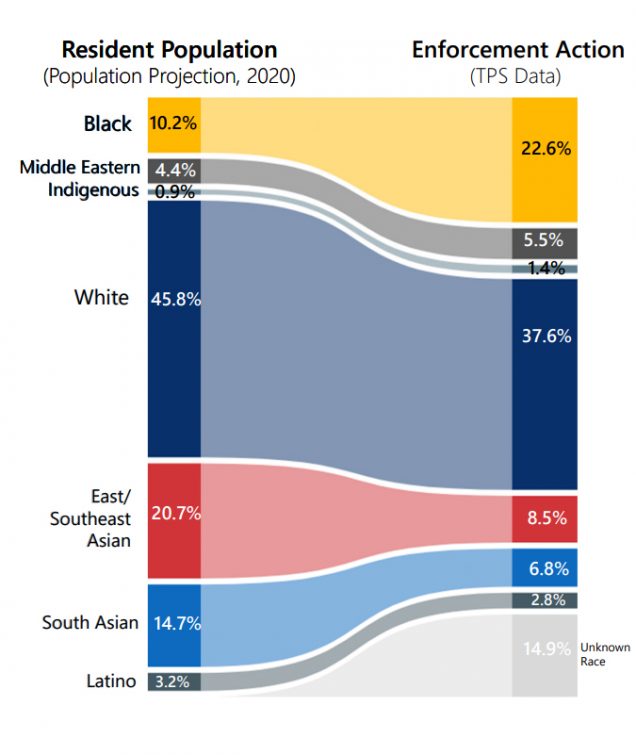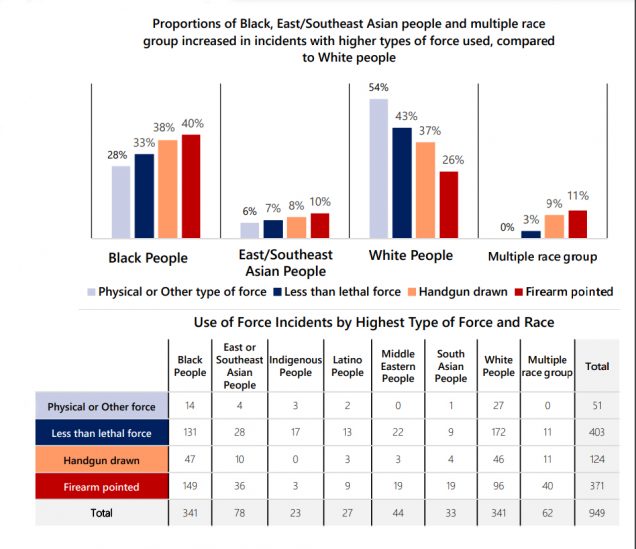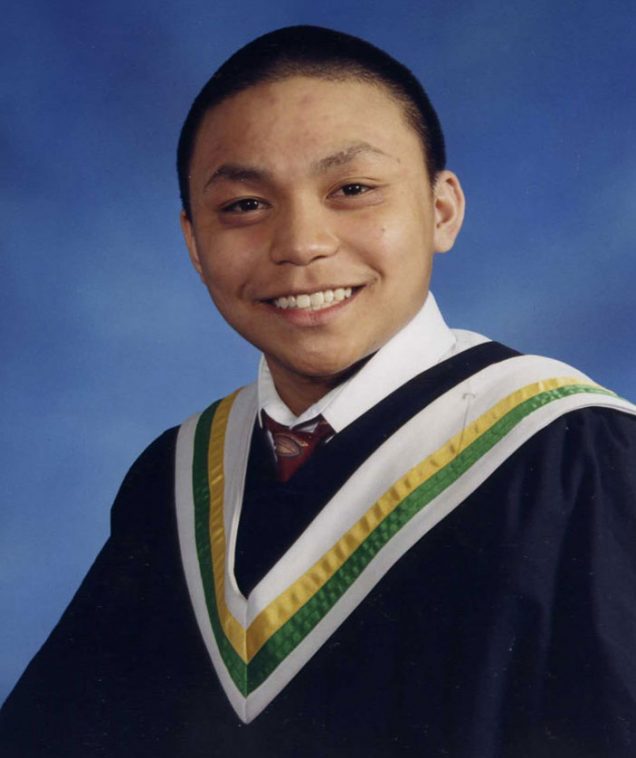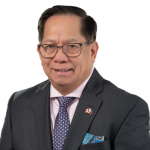Statistics show police use greater force on ethnic minorities
Statistics show police use greater force on ethnic minorities

(Source: Toronto Police Race & Identity Based Data Collection Strategy June 2022 Detailed Report)
Dad recalls 2004 police fatal shooting of Jeffrey Reodica
By Michelle Chermaine Ramos
LJI Reporter
The Philippine Reporter
In an effort to eliminate systemic racism, all police services in Ontario started collecting race data on January 1, 2020, to determine statistics on provincial use of force on the different ethnic groups.
For the purposes of the study, they examined the frequency and types of force used on Black, Middle Eastern, Indigenous, White, East/Southeast Asian, South Asian and Latino people in comparison to their resident populations in Toronto.
Compared to their populations in Toronto, Black people were 2.2 times over-represented in enforcement actions compared to 1.6 times for Indigenous people and 1.3 times for Middle Eastern people.
 Differences in use of force by race
Differences in use of force by race
The study also discovered differences in use of force by race compared to each group’s population.
In 2020, of the 1,224 members of the public involved in use of force incidents, the top three groups were 482 people (39%) who were perceived as Black, 442 (36%) who were perceived as White and 104 (9%) who were perceived as East or Southeast Asian. Those numbers are followed by 72 (6%) who were perceived as Middle Eastern, 49 (4%) perceived as Latino, 49 (4%) perceived as South Asian and 26 (2%) perceived as Indigenous.
However, despite Whites being the second largest ethnic group involved in use of force incidents, when comparing each ethnic group’s population in Toronto, Black people were 1.6 times over-represented in instances of police using force followed by 1.5 times for Latinos, and 1.2 times for East/Southeast Asians and Middle Eastern people.

Types of force used by race
(Source: Toronto Police Race & Identity Based Data Collection Strategy June 2022 Detailed Report)
Contact vs. Conflict
In examining the likelihood of high or low contact with the police versus potential conflict with each ethnic group, results also varied. Indigenous people were more likely to encounter police but had lower rates of being involved in use of force (0.9x). Black and Middle Easterners’ data results showed a high contact, high conflict pattern. East/Southeast Asians and Latinos on the other hand had lower contact with the police but were more likely to experience use of force once they had an enforcement action or police contact.
Highest type of force used by race
Police officers are trained to use different levels of force to deescalate potentially dangerous situations. The study examined use of force incidents by race and types of force involving physical or other force, less than lethal force, a handgun drawn and a pointed firearm. Results showed that Black, South Asian and East/Southeast Asian people were more likely to experience higher uses of force in all categories.

Jeffrey Reodica
Pointed Firearms
Compared to other groups, White people were more likely to experience less dangerous uses of force, with firearms pointed at them ranking the lowest of all categories. On the other hand, incidents with firearms pointed as the highest levels of force were 2 times more likely to involve South Asians, followed by 1.6 times for East/Southeast Asians and 1.5 times for Blacks.
What do these numbers mean for the Filipino-Canadian community? It’s been 18 years since 17 year-old Scarborough high school student Jeffrey Reodica was shot multiple times in the back by a plainclothes police officer on May 21, 2004 and later died in the hospital.
The incident started as a scuffle on May 20, 2004, at a basketball court when two Filipino teens were physically assaulted and verbally bullied by a group of white teens who told them to “go back to the Philippines and eat rice.”
The following day when the same group of white boys armed with baseball bats approached three Filipino teens, more Filipino boys joined in carrying rocks in their hands and started chasing away the white teens around the neighborhood. The Filipino group eventually saw Jeffrey across the street who joined them in searching for the white kids. (READ: How Jeffrey Reodica was shot 3 times – Exclusive interview with a boy who witnessed it all https://philippinereporter.com/index.php/2004/06/01/how-jeffrey-reodica-was-shot-3-times/)
One of the white teens called the police who arrived in an unmarked car in plainclothes. The two undercover cops confronted the Filipino teens who were not informed that they were police officers and thought that the adults were the white teens’ relatives. One undercover officer pulled out a gun and ordered the Filipino teens to kneel and drop the rocks they were holding. The officer’s excessive use of force ended up in Jeffrey being shot in the back several times.

Willie Reodica
For Jeffrey’s father, Willie Reodica, Toronto Police Chief James Ramer’s public apology in light of the data offers no consolation. “That systemic racism has been there during and even before the time my son was murdered. The manner in which George Floyd was confronted by the police, there is a commonality with my son. So, they’re saying that they amended the justice system on the federal level? They haven’t done anything,” he said.
He expressed his frustration and fear for our youth’s safety in encounters with the police. “Be careful if confronted by police because they are the authorities so you have to conduct yourself in a nice manner. Don’t be belligerent. If they tell you to do something, you follow their direction because if you become non-compliant, they can arrest you or lock you up. Be cautious. Let’s say in a confrontation against let’s say a white or non-white, if the police get involved, you have to be sort of compliant and do not talk back. Whatever the police tells you to do, you must act accordingly. They tried to make my son and other youth look like they didn’t respect the police.”
————————————-
RELATED STORIES
Jeffrey Reodica’s 16th death anniversary commemorated (June 12, 2020)
https://philippinereporter.com/index.php/2020/06/12/jeffrey-reodicas-16th-death-anniversary-commemorated/
Jeffrey Reodica issue is still alive (May 23, 2014)
https://philippinereporter.com/index.php/2014/05/23/jeffrey-reodica-issue-is-still-alive/
After 10 years, family, friends still seek justice.
https://philippinereporter.com/index.php/2014/05/23/after-10-years-family-friends-still-seek-justice/
Police Chief Blair in hot seat (November 16, 2009)
https://philippinereporter.com/index.php/2009/11/16/police-chief-blair-in-hot-seat/
Community commits to seek truth and justice in Reodica case (June 1, 2004)
https://philippinereporter.com/index.php/2004/06/01/community-commits-to-seek-truth-and-justice-in-reodica-case/
OTHER SOURCES
Toronto Police Race & Identity Based Data Collection Strategy June 2022 Detailed Report: https://s3.documentcloud.org/documents/22060566/98ccfdad-fe36-4ea5-a54c-d610a1c5a5a1.pdf
Police Interactions with People in Crisis and Use of Force: OIPRD Systemic Review Interim Report March 2017
https://www.oiprd.on.ca/wp-content/uploads/Police-Interactions-with-People-in-Crisis-and-Use-of-Force-Systemic-Review-Report-March-2017-Small.pdf
Comments (0)